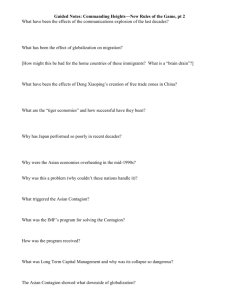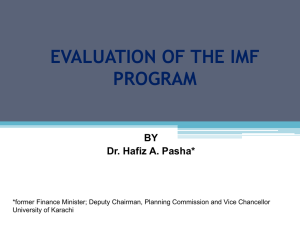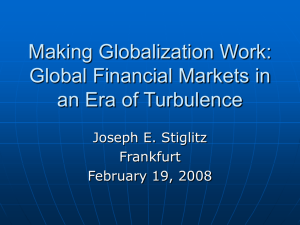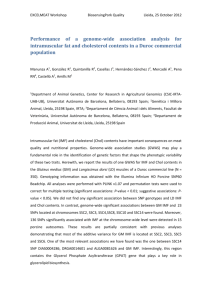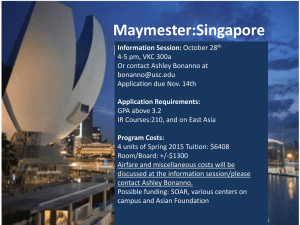Washington consensus
advertisement
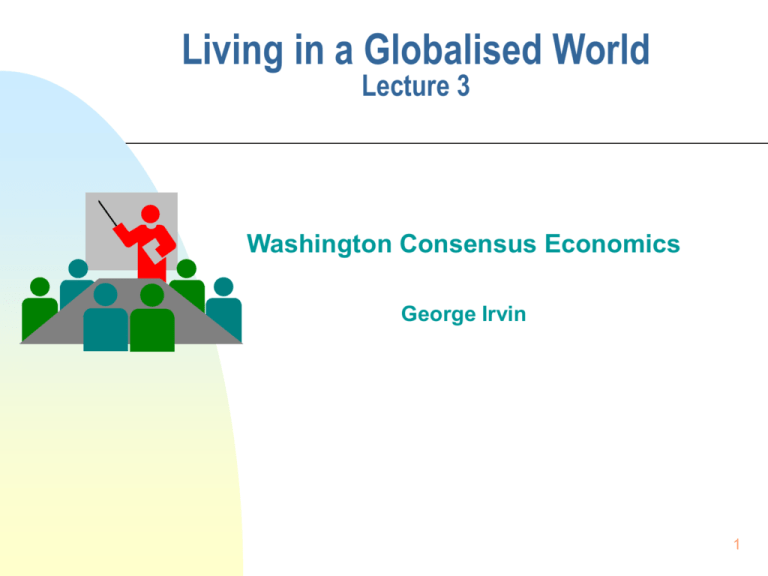
Living in a Globalised World Lecture 3 Washington Consensus Economics George Irvin 1 Outline of Session 1. What is Washington Consensus? 2. Simple Theory: the Savings Balances 3. How good a record? (East Asia revisited) 4. Is there a Brussels-Frankfurt-Washington Consensus? 2 IMF and WB ‘Bretton Woods’ (1944) organisations WB funds Investment Projects & Programmes IMF is CB ‘lender of last resort’ ‘conditional’ tranches why IMF loans needed ‘standby’ agreement and ‘letters of credit’ Regaining ‘creditworthy’ status 3 IMF Basic Recipe 1. Fiscal discipline: cut Govt expenditure to balance budget; independent Central Bank controls inflation 2. Liberalisation of prices and markets: ‘free’ capital markets make labour markets ‘more flexible’, 3. Trade liberalisation: dismantle tariffs; exchange rate liberalisation 4. Shrink the State, mainly by privatising everything that can be privatised; PPPs and PFIs In summary: Fiscal austerity, Liberalisation, Privatisation, 4 Simple Economic Logic Y = C + I + G + (X-M) 2. Disposition of Y identity: Y = C + Sp + T 1. Nat Y identity: gives: C + Sp + T = C + I + G + (X-M); rearranging: 3. Savings balance: (Sp – I) + (T – G) = (X – M) where: (Sp – I) is private savings and investment; (T – G) is the Govt current surplus or deficit; (X – M) is a simplification of the CA balance 5 Key Point Savings balance: (Sp – I) + (T – G) = (X – M) Assume Sp = I; then if T<G, there must be an external deficit: Govt Deficit (-100) => (T – G) = Trade Deficit (-100) (X – M) Main IMF argument: Govt deficit causes trade deficit! 6 More detailed: (Sp – I) + (T – G) = (X – M) Sp: improve financial sector intermediation (end ‘McKinnon-Shaw financial repression) thus enabling Sp to rise; G: too much G finances subsidies to ‘inefficient’ PS enterprises; these should be privatised; i: also, reducing G takes pressure off Government financial borrowing requirement (PBR), enabling i-rts to fall and reducing ‘crowding out’ of private Investment (X- M): end import protection, thus enabling switch of resources exports. In some cases, devalue---although IMF tends to believe in ‘exchange rate anchor’ as a bulwark against inflation---so ‘expenditure cutting’ must be used instead. 7 Liberalising K-Mkt Private capital flows: (world K-markets turnover = $1.6 trillion daily!). Liberalising an LDC’s capital markets means potentially accessing a lot of investor’s money. Short-term ‘Hot money’ is the chief problem: Spectrum of K-Flows Short <= ============================================long Money Mkt & Portfolio I ... DFI Long-term DFI: Direct Foreign Investment (typically in bricks & mortar); can be wholly owned subsidiary, joint venture, management contract, etc. Short-term: called ‘hot money’: it can flow out as quickly as it flows in - Portfolio: stocks & bonds of host country; - Money market: short-term private or public paper, or simply placing money on deposit account drawing high i-rate.. - China has exchange controls: greatly reduces volatility! 8 IMF Crises IMF-Crises: 12 crises in 10 years Mexico (1994-95); Argentina(1995); Thailand (1997) Indonesia (1997) S Korea (1997) Malaysia (1997)* Philippines (1997) ‘tequila crisis’ ‘contagion’ Russia (1998) ‘bailout’: ER aid to save Chase Manhattan Brazil (1999, 2001) Ecuador (1999) Argentina (2001-2) too little too late Asia: induced by ‘financial mkt liberalistion’; * refused IMF advice Turkey (2002) 9 IMF = Reduce Growth East Asia: •IMF-style policies led to falls in 1998 GDP of 14% in Indonesia, 10% in Thailand and 6% in S Korea; unemployment rose and real wages fell (-6% Korea; -7% Thailand; -38% Indonesia). •In all cases the IMF prescription was the same; higher interest rates and rigid budgetary austerity. •Thailand had a large external deficit and Thai banks had borrowed in dollars and lent in baht; when foreign investment dried up, the baht was forced to float---but the budget deficit was not large, and demanding a budget surplus plunged the economy into recession. •In Korea, the internal and external balances were perfectly sound; IMF forced budget-surplus induced contraction which caused serious bankruptcy 10 Is there a Brussels Consensus? Euro is a good thing (protects against currency shocks), but …… Economic Architecture of EU? Central monetary authority (ECB): 2% inflation target Fiscal policy: Stability & Growth Pact constrains statelevel fiscal policy to 3% deficit and automatic stabilisers Long term budget balance: reduces PBR to zero, thus ‘shrinking’ the State Core Eurozone unemployment remains 9% Key point: low growth means high unemployment, cuts in social provision 11 Suggested References: Stiglitz, Joseph (2002) ‘Globalisation and its discontents’ London: Penguin Books Williamson, J. ed (1990) Latin American Adjustment: how much has happened? Washington DC: Institute for International Economics Chang Ha-Joon (2002) ‘Kicking away the ladder: development strategy in historical perspective’ London: Anthem Books. Fitoussi, J-P and F Saraceno (2004) ‘The Brussels-FrankfurtWashington Consensus Old and New Tradeoffs in Economics’ Paris: (OFCE) Observatoire Français des Conjonctures Economiques N° 2004-02, February Irvin, G (2005) ‘The Implosion of the Brussels Consensus’ Torino: ICER, May. www.icer.it Standing, G (2004) ‘Evolution of the Washington Consensus: Economic Insecurity as Discontent’ Geneva: International Labour Office 12 Debate: Resolved: ‘The IMF is a much maligned organisation; it serves the crucial purpose of keeping the world’s governments from indulging in irresponsible spending’ The Case For The Case Against 13



